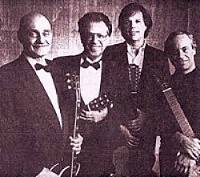Guitar Summit: A Roundtable with Joe Pass, Pepe Romero, Leo Kottke and Paco Peña
by Jeffrey Pepper Rodgers
With 24 strings and 40 fingers, Leo Kottke, Joe Pass, Paco
Peña and Pepe Romero encapsulate a sizable portion of the music made on acoustic guitars in the 20th century. When they took to the stage in San Francisco this winter as part of their Guitar Summit tour, these master guitarists led the audience on a voyage across a broad landscape of European and American music, spanning centuries and continents with only the graceful, sure touch of fingertips on strings. It was clear from all the craning necks that quite a few guitarists were in attendance, but all four players transcended their identities as guitarists with the depth and emotional resonance of their music. That is, after all, why they reached this summit in the first place.
Paco Peña and Pepe Romero represent the guitar's Spanish roots. Peña was born in Cordoba, the melting pot of flamenco, and is one of the world's greatest exponents of that form, both as a solo guitarist and as a traditional accompanist to singers and dancers. Romero, one of the sons of Celedonio Romero who comprise the First Family of classical guitar, is originally from Malaga, Spain, and performs both flamenco and classical repertoire with his family and as a top-notch soloist. Joe Pass and Leo Kottke represent two branches of the American steel-string guitar tree. Pass has been a jazz legend for many decades, negotiating an archtop guitar with jaw-dropping facility and improvisational ingenuity. For his part, Kottke, the youngest of this group, has inspired a whole school of fingerstyle flattop guitar with his entirely unusual and irresistible blend of American folk forms.
An impressive foursome, to say the least, and one that offers an unparalleled view of the diversity of the contemporary guitar scene. On the day after their San Francisco concert, the summit delegation took a few minutes out of their tour schedule to share some thoughts with me on the state of the guitar, and then they led a vastly entertaining workshop for a group of students at the city's Community Music Center (see A Class with the Masters). As this roundtable might suggest, it's hard to imagine a group of virtuosos who are more unassuming and respectful of each other's skills.
It's obvious when you're all on stage together than the styles of music and the instruments you play are very different. But what do flamenco, classical, archtop, and flattop guitars -- and the traditions that they represent -- have in common?
ROMERO
The instruments are basically the same. We all embrace the instruments, we pluck them, we feel the vibration, we love the music we play. The roots of the music are different, but I think there is much more in common than there is a difference. It's mainly, for me, the feeling that we share, whether we are playing or listening to the other one play.
KOTTKE
It's proof of the flexibility of the guitar, that it has that wide a reach, or mechanically that there could be that many functional variations on Torres' design...and D'Angelico's.
PEÑA
I see a very happy phenomenon that has made the guitar a universal vehicle for people to express music. I think it's extraordinary that the guitar has so many different ramifications in so many different cultures. Somehow, it has created an eruption of activity all over the place.
PASS
These instruments have six strings and they're acoustic -- there is no solid-body plank involved in this thing. All of us play with our fingers, which I think is the best and only way to play your guitar, because you're actually in touch with the instrument -- you actually feel it, like a horn player feels a horn in his mouth. I need a little volume on my guitar, but if I had a real good acoustic guitar , I would probably play just acoustic; usually mikes don't work good on a steel-string acoustic guitar. But outside of that, I see no difference between us.
I do see a difference in the guitarists that use those planks and synthesizers and all that junk to alter their sound so that it does not sound like a guitar. It sounds like a keyboard, a trumpet, whatever you want. That is a different instrument totally to me; that is not a guitar.
(photo by Dan Hunstein)